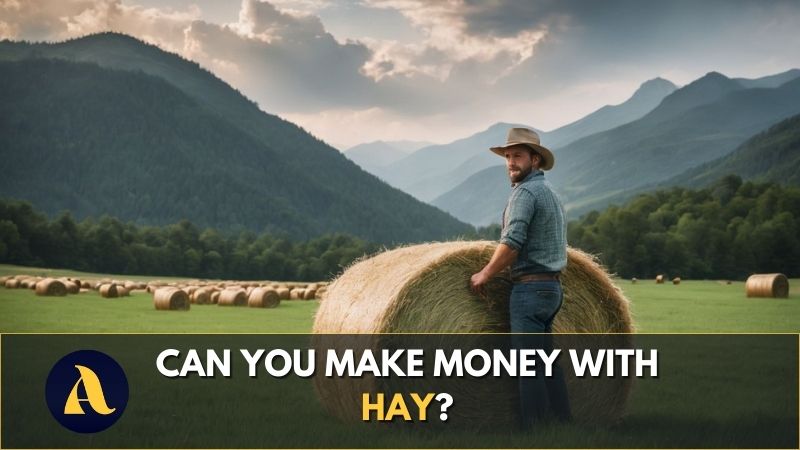Looking for a profitable farming venture? Try hay.
High-quality hay can bring in serious cash. So, let’s talk about how to transform your hay into money – from growing methods to selling strategies.
Are you ready to find out how much money is hidden in those bales of hay?
Let’s get going!

Key Takeaways
- Converting crop acres to hay can unlock a new income stream, but it requires careful planning and investment in haying equipment and infrastructure.
- Growing higher-quality hay is crucial for maximizing profits as it allows you to command higher prices in the market.
- Finding a market for your hay is essential for generating income, whether through direct sales to livestock owners or by exploring alternative markets such as petting zoos or landscaping businesses.
How Much Can You Earn By Selling Hay?
The cost per bale can vary a lot, depending on several factors – the current market, your location, the type of hay, and the size of the bale.
Small square bales can often sell from $3 to $10 per bale. Larger round bales, typically used for feeding larger herds or for commercial use, can sell for $30 to $100 per bale.
It’s best to check local prices for the most accurate estimate.
Considerations for Making Money with Hay
Converting crop acres to hay
Got a crop field? Try switching it to hay.
This could make you more money, but you need to plan carefully. You must consider the costs involved in this transition, which include purchasing or renting haying equipment and altering infrastructure to accommodate storage needs.
Also, hay farming takes a lot of time – you need to take care of your fields and harvest at the right time to get top-quality hay. The health of your soil is also important, so check the soil before you plant alfalfa or other types of hay so you can add anything the soil needs to grow the best crop.
Lastly, farmers need to understand their local market. How much do people want hay for feed or garden mulch? These two things can really affect how much you charge for your hay.
Growing higher-quality hay
To make the most money with hay, you need to grow high-quality hay. If you can improve the quality of your hay, you will get a better price.
This means paying attention to factors like nutrient content, moisture levels, and weed control. Using the right fertilizer, choosing the best types of seeds, and checking the harvest conditions will let you grow amazing hay that livestock owners need and that can fetch a good price.
Also, if your hay is always top quality, your customers will come back for more. So take the time to grow the best hay you can to make the most money in this competitive market.
Finding a market for hay
To make money with hay, you need to find people to buy it.
One way is to sell directly to local people who have livestock or run horse stables. Making friends with other farmers can help you find these buyers.
Or, you might sell through agricultural co-ops or online platforms that specialize in hay sales. Also, look for other places to sell, like petting zoos, wildlife rehabilitation centers, or landscaping businesses that use straw bales.
By finding many types of customers, you increase your chances of finding buyers who are willing to pay good prices for your hay.
Some Factors Affecting Your Profit Potential
What you earn from your hay business can depend on:
- The cost of production
- Pricing strategies
- And market demand.
Let’s take a closer look.

Cost of production
Growing hay can rack up various costs, which can eat into your profits.
It’s crucial to add up your total production costs, including steady and unpredictable expenses. This will help you determine your minimum earning rate.
These costs might include land rent or purchase, equipment repairs and fuel, seed or fertilizer costs, labor wages, and storage expenses. By accurately figuring out these costs, you can make smart choices about your pricing and know what kind of return to expect from your hay business.
Pricing strategies
To bring in top profits from your hay, you need to set your prices carefully.
One strategy involves keeping an eye on market trends and adjusting your prices based on those. By staying savvy about supply and demand, you can take advantage of times of peak demand by charging more for your hay.
Also, setting competitive prices compared to other hay sellers in your area helps reel in more customers and generate consistent sales. But don’t forget to consider things like the quality of your hay, how big your hay bales are, and what your customers like when you set your prices.
Finding that sweet spot between top profit margins and staying competitive in the market is key to a thriving hay business.
Market demand
If you’re looking to turn hay into cash, you need to be mindful of how much people want your hay.
Like any other market, hay prices can vary based on availability.
When there’s a high demand for quality hay and not much supply, you can charge more for your product. But, if there’s a glut of hay in the market, prices might fall.
Staying in the loop with market trends and understanding industry demand are essential to maximize your earnings from selling hay.
Other Income Opportunities from Hayfields
There are additional ways to make money from your hayfields such as:
- Leasing hunting rights,
- Offering hay baling services,
- And utilizing the hay for livestock feed.
Keep reading to learn more!

Leasing hunting rights
Renting out hunting rights is an extra way for hay farmers to make money. By allowing hunters to hunt on their land, farmers can pocket some extra cash and help control the wildlife population on their property at the same time.
Leasing hunting rights is an extra way for hay farmers to make money. By allowing hunters to hunt on their land, farmers can pocket some extra cash and help control the wildlife population on their property at the same time.
Hunting leases can work out great for both sides.
Hunters get access to excellent hunting lands and the farmer earns extra money. The earnings from hunting leases can help cover some of the costs of hay farming and help increase overall profits.
Offering hay baling services
Providing hay baling services is another way to earn money from your hayfields.
By offering this service to other farmers nearby, you can make money and help them save time and effort.
Farmers who don’t have the equipment or skills for baling hay would be glad to pay you for your services. This extra money can add to the profits you make from selling your own hay and help increase the total profits from your hay business.
Utilizing the hay for livestock feed
Feeding your livestock with the hay you produce is a smart move to make more money in your business.
By using your own hay to feed your animals, you avoid the need to sell it and deal with changing market prices.
This not only makes sure your animals always have enough feed, but also lowers costs tied to buying commercial feed. You can check how much you’re saving by figuring out how much it would cost to buy the same amount of feed from a supplier.
Also, feeding top-quality hay to your animals can make your livestock healthier, which could mean you can charge more when you sell them for meat or breeding.
Using this option in your hay business can help boost profits and give you more control over production costs and final sale prices.

Frequently Asked Questions About Hay
Can you really make money with hay production?
Yes, hay production can be profitable if you apply effective farming techniques and strategies to attain high-quality hay yield.
Is it easy to farm hay?
Farming hay isn’t necessarily difficult, but it does require time, effort, planning, and the right equipment. It’s important to consider factors such as soil quality, the weather, and pest management to ensure a good yield.
What hay is the most profitable?
Alfalfa hay is often the most profitable due to its high yield and nutritional value, making it popular among livestock owners.
What equipment do I need for efficient and productive Hay farming?
For efficient Hay farming, proper equipment such as mowers, balers, rakes, and storage facilities are required.
How long after cutting hay can you bale it?
Hay is usually baled a few days after being cut. However, this can depend on the climate – you need dry weather to allow the cut hay to properly cure without molding. Curing (drying) is crucial because it prevents the bale from spoiling once it’s stored.